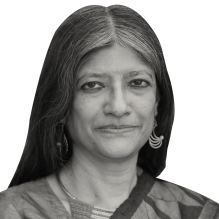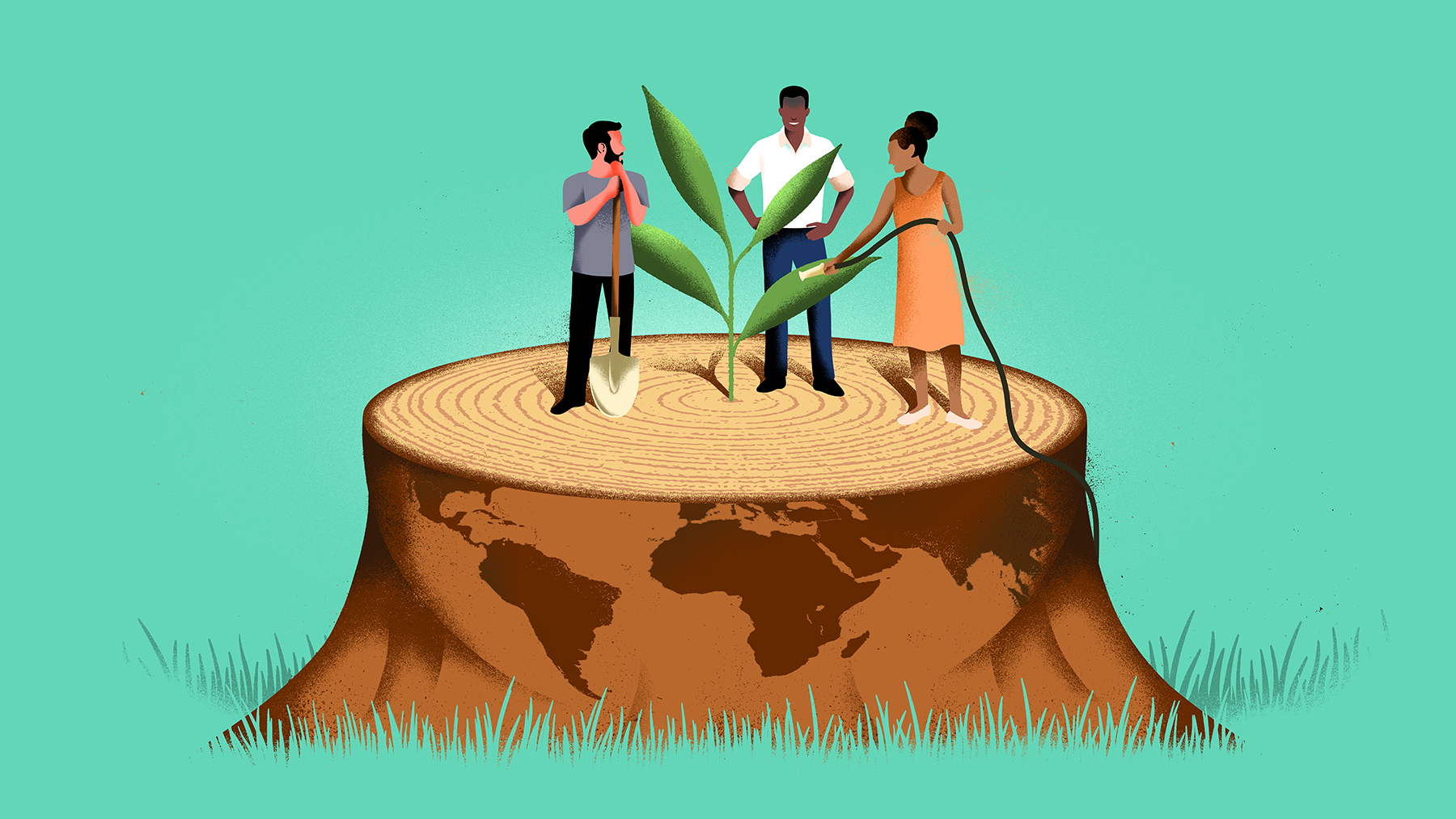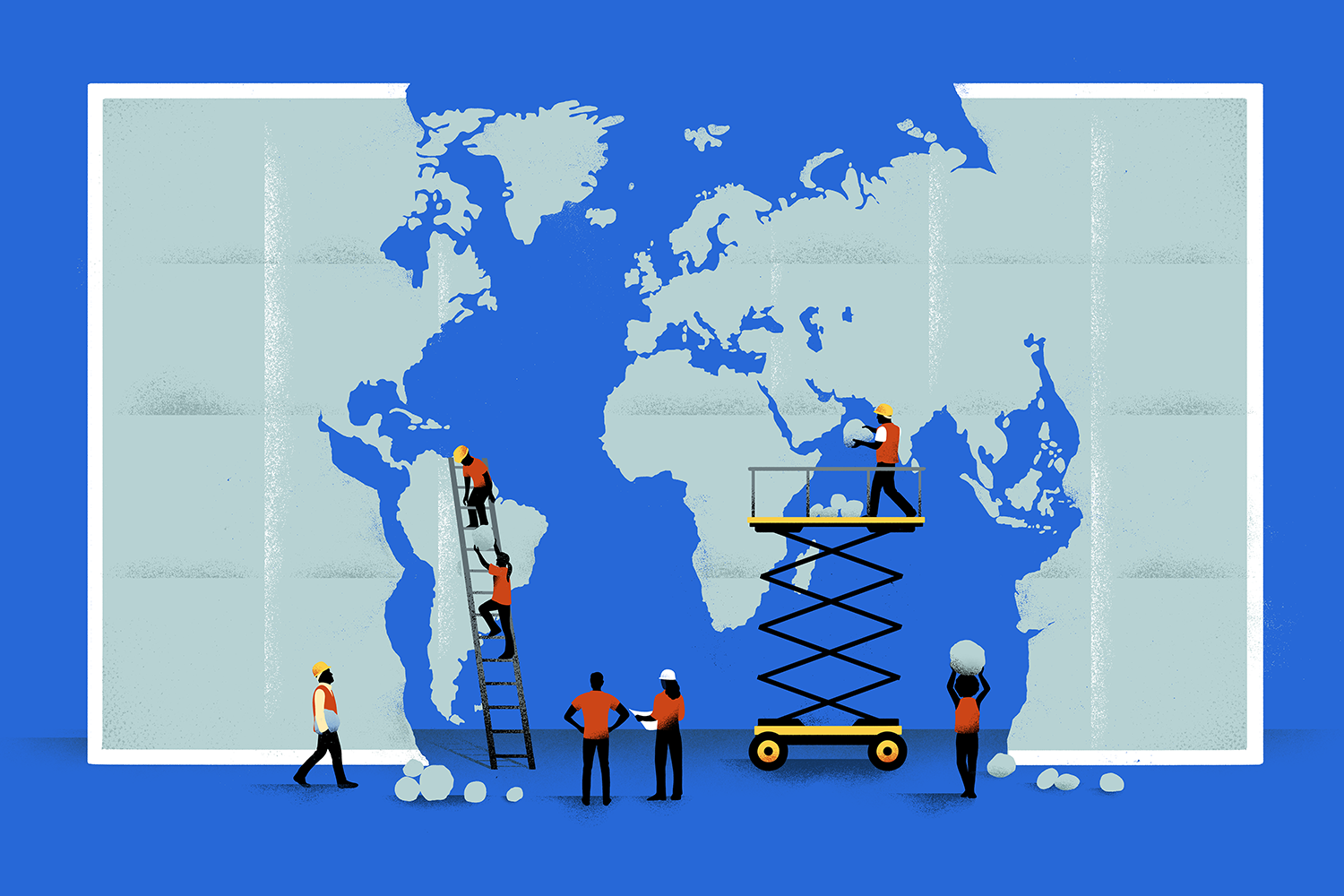
Sébastien Thibault for FP Analytics
Foreign aid cuts and tariff wars. Internal conflicts and climate change. Gender inequality and the unsustainable practice of unpaid care work. It’s easy to see why economics professor Jayati Ghosh calls these and other crises a “perfect storm” for countries facing economic distress. In an interview with FP Analytics, Dr. Ghosh talks about the challenges facing low- and middle-income countries (LMICs), why the current model of global governance isn’t making a dent in the crisis, and why measures of well-being should be among the metrics used to track a country’s growth. The following transcript has been edited for length and clarity.
FP Analytics (FPA): In your view, what are the most pressing challenges and obstacles to effective development interventions in LMICs? And how can local and international actors—independently and in partnership—work to overcome and address these challenges?
Jayati Ghosh (JG): Most developing countries today are facing a “perfect storm” of challenges that are creating overlapping crises and emergencies. Purely by the accident of geography, they are among the worst sufferers from climate change and planetary warming, even though they have been much less responsible for it. Many of them are in the throes of external debt crises—even those that are not facing extreme debt stress or threat of default—because of the very large foreign-exchange debt-service payments they are forced to make. Because of currency hierarchies and often-unjustified risk perceptions in global capital markets, they are directly affected by capital flows resulting from macroeconomic policies in advanced economies—over which they have no control—and then are stymied when faced with compounding crises like wars and pandemics. Food- and fuel-importing countries are similarly adversely affected by price volatility in global markets, being badly hit when commodity prices rise but not seeing equivalent declines when they fall (often because of currency devaluation). An inadequate supply of good-quality jobs, even in “high-growth” countries, results not only in a lack of domestic spending but also social and political tensions. Inequality is growing in all of these countries, which further cements the power of the wealthy to influence laws, regulations, and policies to their own benefit. A growing number of countries affected by internal conflicts and growing violence now have to contend with a lack of external development aid, which had slowed to a trickle but is now almost entirely evaporated.
Among all this bad news, though, there is some good news. First, the current situation has put to rest the myth of export-led growth as the best engine of economic expansion. Only a handful of countries have historically been able to benefit from such a strategy for different geopolitical and political economy reasons. Most others that have tried it have remained stuck in a trap of low-value-added production, with surpluses in global value chains being garnered by preproduction and postproduction activities in multinational companies mostly based in rich countries. This does not mean that exports are unnecessary or should be ignored; rather, it calls for a different and more nuanced strategy with diversified trading partners, regional arrangements, and more emphasis on domestic wage and employment growth. This now seems more likely to occur.
Related to this, there are signs of greater interaction among low- and middle-income countries and greater recognition of the need to work in coalitions around specific issues—for example, more progressive taxation, dealing with illicit financial flows, and technology sharing and transfer in crucial areas such as climate mitigation and adaptation. In some cases, these coalitions may include progressive governments in rich countries.
FPA: You’ve spoken about the importance of looking beyond gross domestic product (GDP) to identify different measures of development and growth. What metrics do you find most pertinent to measure, monitor, and help address today’s development challenges?
JG: The concept of GDP is deeply flawed; it is unable to measure either quality of life or the sustainability of any particular system of production, distribution, and consumption. Moreover, because GDP in most countries captures only market transactions, it excludes a significant number of goods and services produced for personal or household consumption. By making market pricing the chief determinant of value, irrespective of a service’s social value, GDP massively undervalues, for example, what many now recognize as essential but often unpaid care services. At the same time, it overvalues activities, goods, and services that are priced higher because of the oligopolistic structure of markets—financial services being a particularly telling example. The obsession with economic growth independent of other indicators of well-being leads to problematic assessments of the economy’s actual performance and poor policy decisions and outcomes.
There are alternative measures, which must be tracked along with GDP to get a better handle on economic reality. One is a labor-market indicator: the median wage multiplied by the employment rate. The median wage is a better indicator of the conditions faced by most workers than the average wage, which can be overly influenced by high salaries at the top. And the employment rate is a useful indicator not only of the state of demand in the labor market but also of the extent of unpaid labor, which is typically performed by women, since the greater their involvement in such work, the less likely they are able to engage in paid employment. My own research suggests that in the United States and the United Kingdom, for example, per capita GDP dramatically outperformed the labor-market indicator from 2009 to 2020, with a widening gap between the two indicators. In India, the two measures actually moved in different directions, with the labor-market indicator declining even as per capita GDP increased.
Another alternative metric is the proportion of the population that can afford a nutritious diet (according to the United Nations Food and Agriculture Organization’s definition). This indicator is likely to become even more important as the global food crisis worsens, and it does not necessarily move in line with income poverty. In India, for example, 71 percent of the population cannot afford a nutritious diet, despite the fact that the World Bank’s official poverty estimate was around 2.3 percent in 2022 and 2023.
A third measure is a time-use indicator disaggregated by gender. This is particularly useful for capturing the incidence of unpaid care work. This measure shows the distribution of time between paid work, unpaid work, and personal leisure and relational time. Gender-based analysis of time-use data is critical for understanding people’s social and material conditions. It shows the extent to which people experience time poverty, which is far more prevalent among women and the poor. Time-use indicators also reveal the extent to which people provide unpaid labor for society, especially care services that are otherwise unrecognized and unvalued.
A fourth indicator—per capita carbon dioxide emissions—could be helpful for dealing with ongoing climate change and its implications and can help to track other environmental indicators, including those measuring pollution and depletion of nature. Inequality matters here as well: The ratio of the top 10 percent of the population’s per capita carbon dioxide emissions to the bottom half has increased in most countries. Even more striking, the per capita carbon dioxide emissions of the richest 1 percent of the global population have increased dramatically and are now set to be 30 times greater than the level compatible with limiting global warming to 1.5 degrees Celsius by 2030.
If all countries tracked these four indicators regularly, we would have a very different view of comparative economic performance than we do now. And public awareness of this revised view of reality could well mobilize support for different fundamental policies at the national and international level.
FPA: A large and growing evidence base demonstrates that improving gender equality is crucial to accelerating sustainable development. In your view, what are impactful interventions to support gender equality and drive sustainable development that could be scaled up? And what is necessary to ensure progress on gender equality in developing economies and prevent backsliding?
JG: Once it is accepted that economic policies must promote sustainability, gender equality, and social justice, there will be policy implications. First, unpaid care work and the environment cannot be treated—as they have been—as limitless resources, which can be used for free and depleted without cost or consequence. Instead, economic institutions and policies must not only recognize the contributions of care work and nature but be directed toward valuing them socially and providing conditions in which they can flourish.
Investing in care is essential—it cannot be treated as a commodity, personal choice, or family obligation. Rather, care work must be seen as a collective good that is adequately resourced and regulated. Social and financial support to unpaid caregivers must also be increased, including through paid family leave and universal child allowances.
Workers’ rights in the informal economy are particularly important, as women proliferate as small-scale farmers and domestic workers. The expansion of gender-responsive social-protection systems has the macroeconomic advantage of boosting demand as it enables greater social resilience against future economic shocks—including those caused by the escalating environmental crisis.
The global food system also has gendered consequences. It needs to be rebuilt from the bottom up so that it supports diverse crop production in sustainable ways for local, national, and regional markets; provides food security for all; promotes biodiversity; and ensures livelihood security, especially for small producers, including women.
All of this requires a big public spending push through both capital investment and regular budgetary spending in essential services and social protection. That, in turn, demands a global architecture that allows nations to enlarge their “fiscal space” through progressive macroeconomic policies and multilateral cooperation—and especially through tax cooperation, which ensures that multinational companies and the wealthiest people contribute the most. Public spending in support of care and environmental preservation should be seen as part of global public investment rather than as “aid” or consumption.
FPA: In your view, what reforms are needed to multilateral institutions and the current architecture of global governance to move beyond development aid and transform development to meet the most pressing challenges of our time, including climate change?
JG: The major international institutions set up for global economic and financial governance are clearly failing us and not fulfilling the mandates for which they were set up. They are unable to meet even the short-term liquidity needs of countries in distress, much less provide necessary resources for humanity’s major challenges today.
Immediately, it is necessary to address the lack of a global financial safety net. A first step could be to initiate regular allocations of the International Monetary Fund’s reserve asset—special drawing rights (SDRs). To enhance the intervention’s impact, the SDRs could be distributed according to need—a departure from the current approach, which allocates SDRs in proportion to IMF quotas, meaning that the largest shares go to the countries least in need. The IMF could also introduce SDR swaps to meet the immediate liquidity needs of economies that don’t benefit from the U.S. Federal Reserve’s central bank liquidity swaps.
But this is only the first and most minimally necessary step. The world’s approach to tackling shared challenges—climate change, public health, sustainable development—is simply not working, and now leading economies have even stopped trying. International pledges and agreements have fallen far short in terms of both scale and quality. The “billions to trillions” vision—which sought to leverage public subsidies to unlock private finance for climate action—has not been realized.
This means multilateral public financial institutions must play a greater role. This will require, for starters, fundamental reform of the IMF and the World Bank. Both institutions need to adopt a more countercyclical approach to lending. Moreover, they must stop linking loans to oppressive conditions that favor the interests of global capital over the well-being of people and the planet. In general, multilateral banks must increase their lending significantly to meet social, developmental, and climate needs, which in turn requires robust, reliable funding.
But there is a major barrier to such changes: Important decisions at the IMF and World Bank require an 85 percent voting majority, and with a 16 percent share of those votes, the United States effectively wields a veto. Without major governance reforms, these institutions will remain hamstrung, countries will increasingly find ways to bypass them, and they will fade into irrelevance.
At the same time, international financial regulations should be strengthened, including by pursuing greater coordination of national laws. Private finance, which has enjoyed decades of lax regulation and positive incentives, should be required to align its behavior with social and planetary goals— with not only carrots but also sticks, or at least some adverse consequences to be faced if such minimum conditions are not met.
FPA: How can global public investment unlock development gains? Who are the key actors in this space, and what next steps are necessary to not only build momentum but also establish a governance framework?
JG: It is now abundantly clear that “donor” countries are even less likely than before to close the development-financing gap, which was never even partially met. In any case, that was the wrong model, based on notions of patronage and charity rather than meeting common challenges together. It is time to work toward a completely different model, one of “global public investment,” with all countries contributing to the provision of shared public goods according to their means. There are some obvious candidates for such an approach even among existing multilateral institutions, such as the World Health Organization.
At present, such ideas may seem like wishful thinking, because politics and economic frameworks in several rich and powerful nations have taken the completely opposite turn. But if humanity is indeed to step back from the brink of planetary destruction and unlivable societies and economies, global cooperation along these lines is essential. The 4th International Conference on Financing for Development, recently held in Seville, Spain, showed that there is more willingness among some global leaders to push this approach, beginning with coalitions of like-minded governments. This is clearly an issue that must be taken up more actively by civil society as well—for people everywhere to push their governments to genuine cooperation, not just for the broader social good and need for survival but for their own enlightened self-interest.
Dr. Jayati Ghosh taught economics at Jawaharlal Nehru University in New Delhi for 35 years and is currently Professor of Economics at the University of Massachusetts Amherst. From 2002 to 2021, she was the Executive Secretary of International Development Economics Associates. She has advised governments in India and other countries and consulted for various international organizations. She has also been a member of several international boards and commissions, including the UN High-Level Advisory Board on Economic and Social Affairs, the WHO Council on the Economics of Health for All, the UN Secretary-General’s High-Level Advisory Board on Effective Multilateralism, the Club of Rome, and the Jubilee Commission created by Pope Francis.
More on Development Aid
Fixing Foreign Aid
Episode 1: How have the recent cuts in foreign aid impacted countries in the global south? And how did so many countries become reliant on foreign aid to begin with?
Tackling Sovereign Debt
Episode 2: How can we ensure countries looking to finance their future don’t have to mortgage away their present?
Reforming Global Finance
Episode 3: What can the World Bank and International Monetary Fund do to ensure more countries from the global south have a seat at the table?




